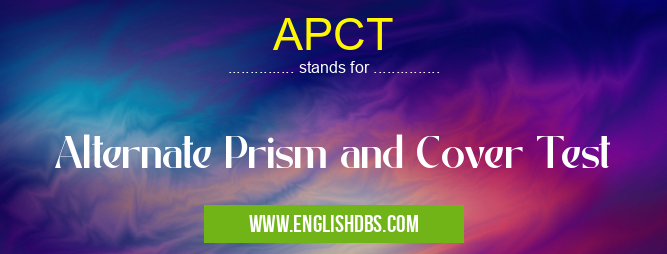What does APCT mean in UNCLASSIFIED
The Alternate Prism and Cover Test (APCT) is a simple and effective optometric test used to evaluate the alignment and coordination of the eyes. It is commonly employed to detect and assess oculomotor dysfunctions, particularly strabismus and binocular vision anomalies.

APCT meaning in Unclassified in Miscellaneous
APCT mostly used in an acronym Unclassified in Category Miscellaneous that means Alternate Prism and Cover Test
Shorthand: APCT,
Full Form: Alternate Prism and Cover Test
For more information of "Alternate Prism and Cover Test", see the section below.
Procedure
The APCT involves alternating the placement of a prism and a cover over one eye at a time. The prism is used to induce a vertical displacement of the image, while the cover temporarily occludes vision in one eye. The examiner observes the response of the uncovered eye to the prism-induced shift.
Observation
- Positive APCT: When the prism is placed over one eye, the uncovered eye moves in the direction opposite to the prism's base. This indicates exotropia (outward deviation of the eye).
- Negative APCT: When the prism is placed over one eye, the uncovered eye moves in the same direction as the prism's base. This indicates esotropia (inward deviation of the eye).
- Neutral APCT: The uncovered eye shows minimal or no movement in response to the prism. This indicates that the eyes are properly aligned in the horizontal plane.
Clinical Significance
APCT helps identify and quantify the type and severity of strabismus, including:
- Horizontal deviations (esotropia and exotropia)
- Vertical deviations (hypertropia and hypotropia)
- Oblique deviations (incyclotropia and excyclotropia)
Essential Questions and Answers on Alternate Prism and Cover Test in "MISCELLANEOUS»UNFILED"
What is the Alternate Prism and Cover Test (APCT)?
The APCT is an ophthalmological test used to evaluate binocular vision and detect strabismus (eye misalignment). It involves placing a prism over one eye and observing the eye's response when the other eye is covered.
How does the APCT work?
The prism alters the direction of light entering the eye, causing the image to shift. When the other eye is covered, the eye with the prism will move to realign the image. The direction and magnitude of the eye movement provide information about the type and severity of any misalignment.
What are the indications for an APCT?
Indications include:
- Suspected strabismus
- Abnormal head posture or eye movements
- Double vision
- Difficulty with depth perception
What can the APCT diagnose?
The APCT can diagnose various types of strabismus, including:
- Esotropia (inward turning of the eye)
- Exotropia (outward turning of the eye)
- Hypertropia (upward turning of the eye)
- Hypotropia (downward turning of the eye)
How is an APCT performed?
The test is usually performed by an ophthalmologist or optometrist. The patient wears a pair of glasses with a prism in front of one eye. The other eye is then covered, and the doctor observes the eye movement of the uncovered eye.
Is the APCT painful?
The APCT is generally not painful, although some patients may experience mild discomfort from wearing the glasses or having their eye covered.
What are the limitations of the APCT?
The APCT may not be reliable in certain cases, such as:
- Patients with very young or very poor vision
- Patients with certain neurological conditions
- Patients who are not able to cooperate with the test
Final Words: The Alternate Prism and Cover Test is a valuable diagnostic tool in optometry. It provides essential information about eye alignment and coordination, enabling clinicians to diagnose and manage strabismus and other oculomotor disorders effectively.
APCT also stands for: |
|
| All stands for APCT |
